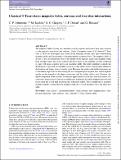Files in this item
Classical T Tauri stars : magnetic fields, coronae, and star-disc interactions
Item metadata
| dc.contributor.author | Johnstone, C. P. | |
| dc.contributor.author | Jardine, Moira Mary | |
| dc.contributor.author | Gregory, Scott | |
| dc.contributor.author | Donati, J. -F. | |
| dc.contributor.author | Hussain, G. | |
| dc.date.accessioned | 2014-01-13T12:31:01Z | |
| dc.date.available | 2014-01-13T12:31:01Z | |
| dc.date.issued | 2014-02-01 | |
| dc.identifier | 78946856 | |
| dc.identifier | ed96f193-1acf-40ce-9879-92500607dbc5 | |
| dc.identifier | 84891350295 | |
| dc.identifier | 000329177100016 | |
| dc.identifier.citation | Johnstone , C P , Jardine , M M , Gregory , S , Donati , J -F & Hussain , G 2014 , ' Classical T Tauri stars : magnetic fields, coronae, and star-disc interactions ' , Monthly Notices of the Royal Astronomical Society , vol. 437 , no. 4 , pp. 3202-3220 . https://doi.org/10.1093/mnras/stt2107 | en |
| dc.identifier.issn | 0035-8711 | |
| dc.identifier.other | ArXiv: http://arxiv.org/abs/1310.8194v1 | |
| dc.identifier.other | ORCID: /0000-0002-1466-5236/work/57821820 | |
| dc.identifier.uri | https://hdl.handle.net/10023/4359 | |
| dc.description | 21 pages, 14 figures, 5 tables, accepted for publication in MNRAS | en |
| dc.description.abstract | The magnetic fields of young stars set their coronal properties and control their spin evolution via the star-disc interaction and outflows. Using 14 magnetic maps of 10 classical T Tauri stars (CTTSs) we investigate their closed X-ray emitting coronae, their open wind-bearing magnetic fields, and the geometry of magnetospheric accretion flows. The magnetic fields of all the CTTSs are multipolar. Stars with simpler (more dipolar) large-scale magnetic fields have stronger fields, are slower rotators, and have larger X-ray emitting coronae compared to stars with more complex large-scale magnetic fields. The field complexity controls the distribution of open and closed field regions across the stellar surface, and strongly influences the location and shapes of accretion hot spots. However, the higher order field components are of secondary importance in determining the total unsigned open magnetic flux, which depends mainly on the strength of the dipole component and the stellar surface area. Likewise, the dipole component alone provides an adequate approximation of the disc truncation radius. For some stars, the pressure of the hot coronal plasma dominates the stellar magnetic pressure and forces open the closed field inside the disc truncation radius. This is significant as accretion models generally assume that the magnetic field has a closed geometry out to the inner disc edge. | |
| dc.format.extent | 19 | |
| dc.format.extent | 3367368 | |
| dc.language.iso | eng | |
| dc.relation.ispartof | Monthly Notices of the Royal Astronomical Society | en |
| dc.subject | Circumstellar matter | en |
| dc.subject | Coronae | en |
| dc.subject | Magnetic field | en |
| dc.subject | Pre-main sequence | en |
| dc.subject | Rotation | en |
| dc.subject | T Tauri | en |
| dc.subject | Herbig Ae/Be | en |
| dc.subject | QB Astronomy | en |
| dc.subject.lcc | QB | en |
| dc.title | Classical T Tauri stars : magnetic fields, coronae, and star-disc interactions | en |
| dc.type | Journal article | en |
| dc.contributor.sponsor | Science & Technology Facilities Council | en |
| dc.contributor.sponsor | Science & Technology Facilities Council | en |
| dc.contributor.institution | University of St Andrews. School of Physics and Astronomy | en |
| dc.identifier.doi | https://doi.org/10.1093/mnras/stt2107 | |
| dc.description.status | Peer reviewed | en |
| dc.identifier.grantnumber | ST/J001651/1 | en |
| dc.identifier.grantnumber | ST/J003255/1 | en |
This item appears in the following Collection(s)
Items in the St Andrews Research Repository are protected by copyright, with all rights reserved, unless otherwise indicated.

